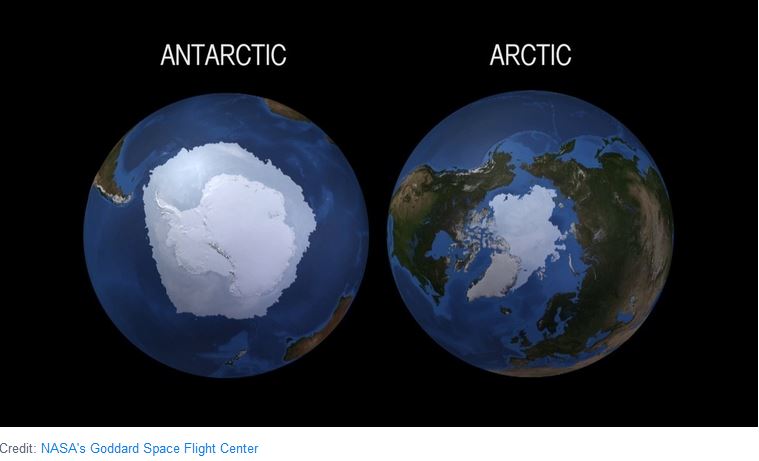
Poles Apart: Arctic v. Antarctic
I was curious about how this trip to the Arctic would be different from my trip to the Antarctic. I though a good starting point would be to explore the ways in which the two regions themselves differ.
So, I created the table below to show some of the interesting things I came up with. This is by no means an exclusive list. It contains just those points which took my fancy (plus some boring facts I thought were worthy)
| Arctic – sea surrounded by land | Antarctic – land surrounded by sea | |
|---|---|---|
| Area | The area of the Arctic region is approximately 14.5 million square kilometres, of which about 40% is land | The Antarctic region is very similar at 14.2 million square kilometres, but with 98% of land |
| Origin of the names | The word Arctic originates from the Greek word for bear, referring to the names of the two constellations in the northern sky (Big Bear and Little Bear) | Antarctic literally means “opposite the bear”. It is serendipitous that polar bears only exist in the Arctic and not in the Antarctic, this fact often being cited as the origin of the names |
| When did people occupy the land? | In 2012 a young boy discovered a frozen woolly mammoth which had been slain. It was dated to 45,000 years ago, suggesting that the migration of people across Siberia from Asia occurred as far back as then. | Antarctica is the only continent which has had no permanent human habitation (and still doesn’t) |
| Exploration | The Greek seafarers were the first to explore the Arctic region in 325 BCE | Antarctica was first discovered by Europeans in the 1820s. However, it is possible that Polynesian explorers discovered it in the 7th century CE |
| Which is the coldest? | Average temperatures rage from minus 40 degrees Celcius to 0 degrees. The coldest temperature recorded was minus 69.6 degrees Celcius in Greenland in 1991 | Average temperatures range from minus 60 degrees Celcius to minus 28 degrees Celcius. The coldest temperature recorded was minus 93.3 degrees Celcius on the East Antarctic ice sheet in 2013 |
| Wildlife unique to the region. (I’m sure there are others) | Polar bears! | Penguins! |
| Population | Approximately 4 million people | Fluctuates between around 1,000 to 5,000 people who temporarily live on Antarctic research bases |
| Sea ice (frozen seawater floating on the surface) | Sea ice tends to stay in the Arctic Circle and so survives longer; some of it lasting from year to year. Arctic sea ice is typically 2 to 3 metres thick | Because the Antarctic sea ice is exposed to open ocean it moves more freely and so floats north and melts. Antarctic sea ice is typically 1 to 3 metres thick |
| Ice sheet (glacial land ice) Together, the Antarctic and Greenland Ice Sheets contain more than 99% of the land ice and over 68% of the fresh water on Earth | The Greenland Ice Sheet: – covers nearly 1.7 million square kilometres – measures 3 km at its thickest point – contains 2.9 million cubic kms of ice – would raise the sea level approximately 7.4 metres if melted | The Antarctic Ice Sheet: – covers nearly 14 million square kilometres – measures 4.9 km at its thickest point – contains 30 million cubic kms of ice – would raise the sea level approximately 60 metres if melted |
Sources of Information:
-
Coolantarctica.com
-
NSID.org (National Snow and Ice Data Center)
-
Climate.nasa.gov